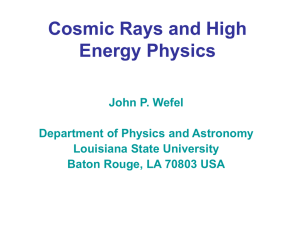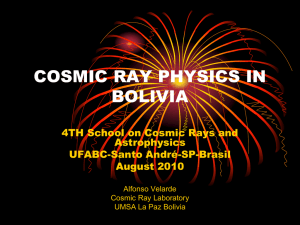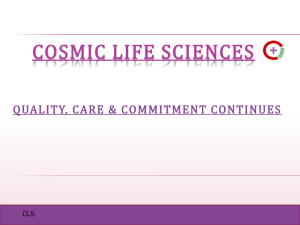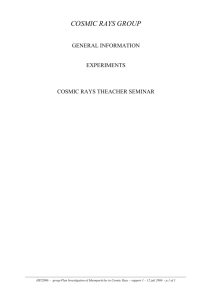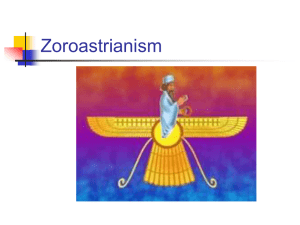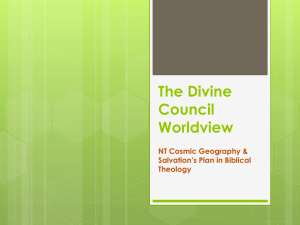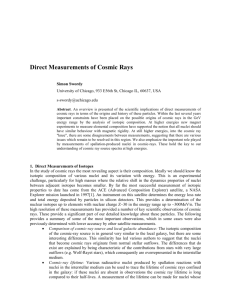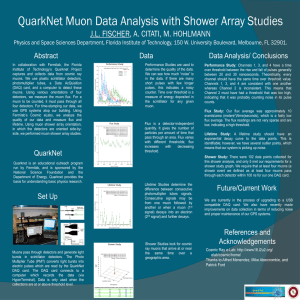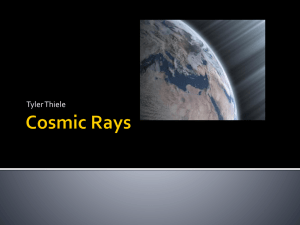2011 QuarkNet Introduction - Day 1
advertisement
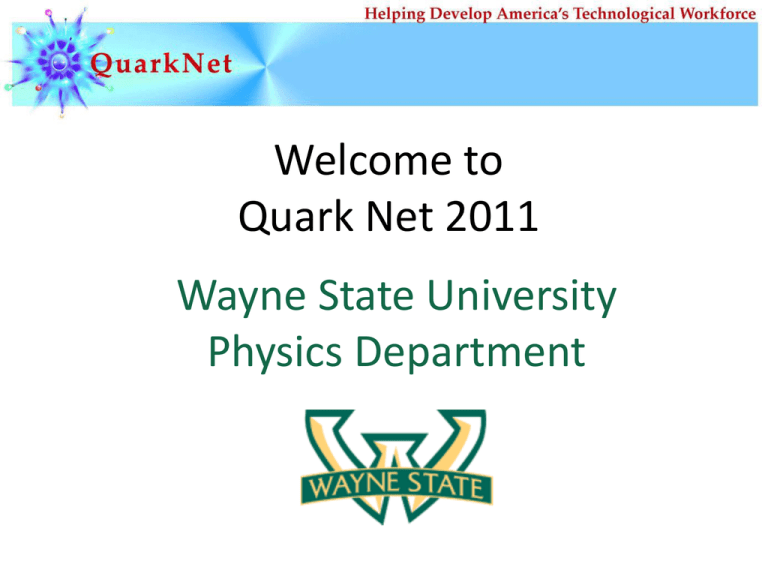
Welcome to Quark Net 2011 Wayne State University Physics Department Agenda for Today 9 – 10 10- 11 Welcome / Introductions / paperwork / ND Pre-test Explain goal of program Introduce e-Lab elab pretest 11 – 12 Cosmic Ray Intro 12 – 1 Lunch 1–3 Rebuild Detectors 3-4 Start Plateauing CRMD Goals for Workshop • Develop a deeper understanding of Physics content • Introduction to Inquiry based learning • Introduction to elementary particles • Methods of experimentation with particles • Overview of current Physics experimentation – FermiLab – CERN Teaching and Learning with Cosmic Rays Workshop Expectations: •Full attendance is required – all two weeks •Hours and schedule: 9:00 – 4:00 (ish) •Start everyday in Physics Room 115 •No other distractions Teaching and Learning with Cosmic Rays Workshop Goals for Students: •Learn and Understand: – The nature of particle Physics – The methods of good scientific inquiry •Conduct Research on Cosmic ray activity – Assemble Cosmic Ray Muon Detectors – Learn the operation of the equipment and the software •Prepare a report (PowerPoint) summarizing: – What was learned – The research conducted and the results Cosmic Ray e-Lab http://www.i2u2.org/elab/cosmic Cosmic Ray e-Lab http://www.i2u2.org/elab/cosmic Team 1: Mohamed Ali-Hussein & Ayasha Jabber Log in: Hamtramck Password: condheat Team 2: Ali Elreichouni & Kayla Price Log in: WSU Session 3 Password: cosmic Go online now and take the pretest. Teaching and Learning with Cosmic Rays Cosmic Ray e-Lab Teaching and Learning with Cosmic Rays • QuarkNet Overview • QuarkNet Cosmic Ray Detector Assemble CRMD hardware and take data. • Cosmic Ray e-Lab Exploration Upload and analyze data. Teaching and Learning with Cosmic Rays Workshop Objectives: • Assemble CRMD: plateau, geometry, datatake. • Record progress: LogBook. • Design e-Lab investigation: data, tools, plots. • Write report, present results. • Share “Implementation Plan” and strategy. Teaching and Learning with Cosmic Rays • Cosmic Rays – – – – Sources Composition, energy spectrum Detection Current experiments • The QuarkNet Classroom Detector – Hardware overview – Classroom use – Experiments, measurements • Data Analysis – Upload, analyze data & save data products. – Share results. – Enter logbook notes. Teaching and Learning with Cosmic Rays Cosmic Ray e-Lab Stats: May 2010 • 774 teachers accounts • 1,515 student research groups • 519 DAQs worldwide • 335 detectors in high schools • 27,548 data files • 498 posters What is Quarknet? QuarkNet creates a collaboration of users: Teachers Students Teachers Mentor Scientists Detector Schools Non-Detector Schools World-wide Network: Students Students Physicists, teachers & their students collaborate on research projects and investigations. • Scientists as mentors • Teachers as researchers & facilitators • Students as researchers Teaching and Learning with Cosmic Rays CRMD Expectation: Not “plug & play” Assembling and thinking required Direct analogue of the big Tevatron & LHC detectors CDF ATLAS Note: Images are not to scale CMS QuarkNet Vision A lasting community of researchers that includes high school teachers and students as well as physicists “Doing science.” School science reflects the practice of science. Science Is what students DO, not what is done to them. Why QuarkNet? Our understanding of the universe is changing as a new accelerator, the LHC, and its experiments, ATLAS, CMS, ALICE and LHCb, gather data. Join particle physicists to work on physics projects exploring the nature of matter, energy, space and time. QuarkNet Origins CDF & DØ at Fermilab Quark Net Origins ATLAS and CMS at CERN Current Active Centers Current Status • 53 Active centers • 158 Mentors • 615 Teachers • 108 Summer students The QuarkNet Collaboration Cosmic Ray Detector • Teachers’ idea • Several prototypes • Collecting data led to e-Lab Student Summer Research 11 centers with 4 student slots each (avg) Teaching and Learning with Cosmic Rays Cool Science Simulation


